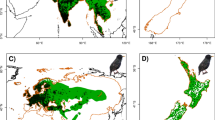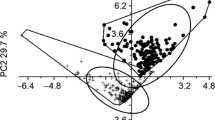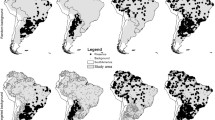Abstract
The non-native invasive anuran Lithobates catesbeianus is presently distributed in Brazil, especially in the Atlantic Rainforest biodiversity hotspot. Here, we use a maximum entropy ecological niche modeling algorithm (i) to model the North American native geographic distribution of this species and (ii) to project that model onto the whole of Brazil. After applying a threshold value that balances commission and omission errors, the projection results suggested high probabilities of occurrence mostly in southern and southeastern Brazil. We also present the first report on the species known distribution in Brazil, showing good agreement with model predictions. If the predictive map is interpreted as depicting invasiveness potential of L. catesbeianus, strategies to prevent further invasion in Brazil should be focused especially in the Atlantic Rainforest biodiversity hotspot.

Similar content being viewed by others
References
Begon M, Harper JL, Townsend CR (1996) Ecology: individuals, populations and communities. Blackwell Scientific Publications, Oxford
Borges-Martins M, Di-Bernardo M, Vinciprova G, Measey J (2002) Geographic distribution. Rana catesbeiana. Herpetol Rev 33:319
Bruening S (2002) Rana catesbeiana. In: Animal diversity Web. University of Michigan Museum of Zoology. Available at: http://www.animaldiversity.ummz.umich.edu/site/accounts/information/Rana_catesbeiana.html. Cited 24 April 2007
Conte CE, Rossa-Feres DC (2006) Diversidade e ocorrência temporal da anurofauna (Amphibia, Anura) em São José dos Pinhais, Paraná, Brasil. Rev Bras Zool 23:162–175
Dixo M, Verdade VK (2006) Leaf litter herpetofauna of the Reserva Florestal de Morro Grande, Cotia (SP). Biota Neotrop 6:0-0. On-line journal: http://www.biotaneotropica.org.br/v6n2/pt/abstract?article+bn00806022006
Elith J, Graham CH et al (2006) Novel methods improve prediction of species’ distributions from occurrence data. Ecography 29:129–151
Feix RD, Abdallah PR, Figueiredo MRC (2006) Resultado econômico da criação de rã em regiões de clima temperado, Brasil. Info Econ 36:70–80
Ficetola GF, Thuiller W, Miaud C (2007) Prediction and validation of the potential global distribution of a problematic alien invasive species—the American bullfrog. Diversity Distrib 13:476–485
Fielding AH, Bell JF (1997) A review of methods for the assessment of prediction errors in conservation presence/absence models. Env Conserv 24:38–49
Fontanello D, Ferreira CM (2007) Histórico da Ranicultura Nacional. http://www.aquicultura.br/. Cited 22 Apr 2007
GBIF—Global Biodiversity Information Facility (2007) Free and open access to biodiversity data. http://www.gbif.org/. Cited 21 Apr 2007
Guisan A, Thuiller W (2005) Predicting species distribution: offering more than simple habitat models. Ecol Lett 8:993–1009
Herpnet (2007) Specimens searching portal. http://www.herpnet.org/. Cited 2 Jul 2007
Hijmans RJ, Guarino L, Rojas E (2002) DIVA-GIS. A geographic information system for the analysis of biodiversity data. Manual—International Potato Center, Lima
Hijmans RJ, Cameron SE, Parra JL, Jones PG, Jarvis A (2005) Very high resolution interpolated climate surfaces for global land areas. Int J Climatol 25:1965–1978
Instituto Hórus (2007) Base de dados de espécies exóticas invasoras no Brasil. http://www.institutohorus.org.br/pr_trabalhos.htm. Cited 23 Apr 2007
Jeganathan P et al (2004) Modelling habitat selection and distribution of the critically endangered Jerdon’s courser Rhinoptilus bitorquatus in scrub jungle: an application of a new tracking method. J Appl Ecol 41:224–237
Kiesecker JM, Blaustein AR (1998) Effects of introduced bullfrog and smallmouth bass on microhabitat use, growth, and survival of native red-legged frogs (Rana aurora). Conserv Biol 12:776–787
Lowe S, Browne M, Boudjelas S, De Poorter M (2000) 100 of the World’s worst invasive alien species a selection from the global invasive species database. The Invasive Species Specialist Group (ISSG), Auckland
Manel S, Williams HC, Ormerod SJ (2001) Evaluating presence-absence models in ecology: the need to account for prevalence. J Appl Ecol 38:921–931
Moyle PB (1973) Effects of introduced bullfrogs, Rana catesbeiana, on the native frogs of the San Joaquin Valley, California. Copeia 1:18–22
Myers N, Mittermeier RA, Mittermeier CG, Fonseca GAB, Kent J (2000) Biodiversity hotspots for conservation priorities. Nature 403:853–858
Papes M, Peterson AT (2003) Predicting the potential invasive distribution for Eupatorium adenophorum Spreng. in China. J Wuhan Bot Res 21:137–142
Peterson AT, Vieglais DA (2001) Predicting species invasions using ecological niche modeling: new approaches from bioinformatics attack a pressing problem. BioScience 51:363–371
Peterson AT, Scachetti-Pereira R, Kluza DA (2003) Assessment of invasive potential of Homalodisca coagulata in western North America and South America. Biota Neotrop 3:0-0:Online journal: http://www.biotaneotropica.org.br/v3n1/pt/abstract?article+BN00703012003
Phillips SJ, Anderson RP, Schapire RE (2006) Maximum entropy modeling of species geographic distributions. Ecol Model 190:231–259
Silvano DL, Segalla MV (2005) Conservation of Brazilian amphibians. Conserv Biol 19:653–658
Thuiller W, Brotons L, Araújo MB, Lavorel S (2004) Effects of restricting environmental range of data to project current and future species distributions. Ecography 27:165–172
Young BE (ed) (2007) Distribución de las especies endémicas en la vertiente oriental de los Andes en Perú y Bolivia. NatureServe, Arlington
Young BE, Lips KR, Reaser JK et al (2001) Population declines and priorities for amphibian conservation in Latin América. Conserv Biol 15:1213–1223
Acknowledgements
We are grateful to Marinez Siqueira for discussion and suggestions on early versions of the manuscript and to Denise Rossa-Feres and Reuber Brandão for valuable information about bullfrog distribution in Brazil. J. G. R. Giovanelli was supported by NatureServe and CNPq (# 130315/2007-9) schorlarships. This work was supported by the FAPESP Research Grant # 05/52727-5 to J. Alexandrino, and CNPq and FAPESP (01/13341-3) research grants to C. F. B. Haddad.
Author information
Authors and Affiliations
Corresponding author
Rights and permissions
About this article
Cite this article
Giovanelli, J.G.R., Haddad, C.F.B. & Alexandrino, J. Predicting the potential distribution of the alien invasive American bullfrog (Lithobates catesbeianus) in Brazil. Biol Invasions 10, 585–590 (2008). https://doi.org/10.1007/s10530-007-9154-5
Received:
Accepted:
Published:
Issue Date:
DOI: https://doi.org/10.1007/s10530-007-9154-5




